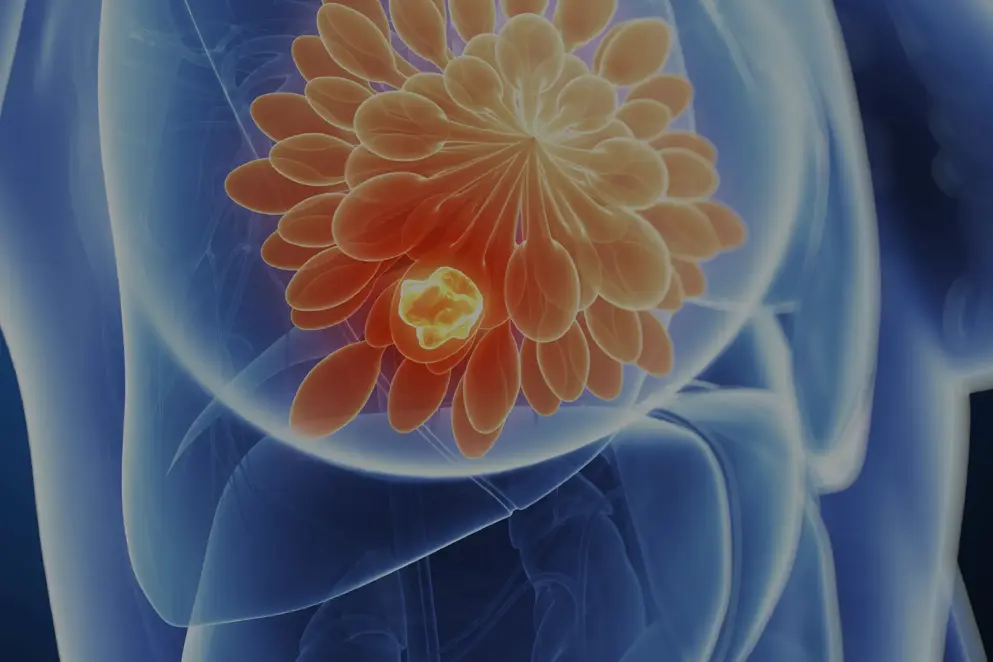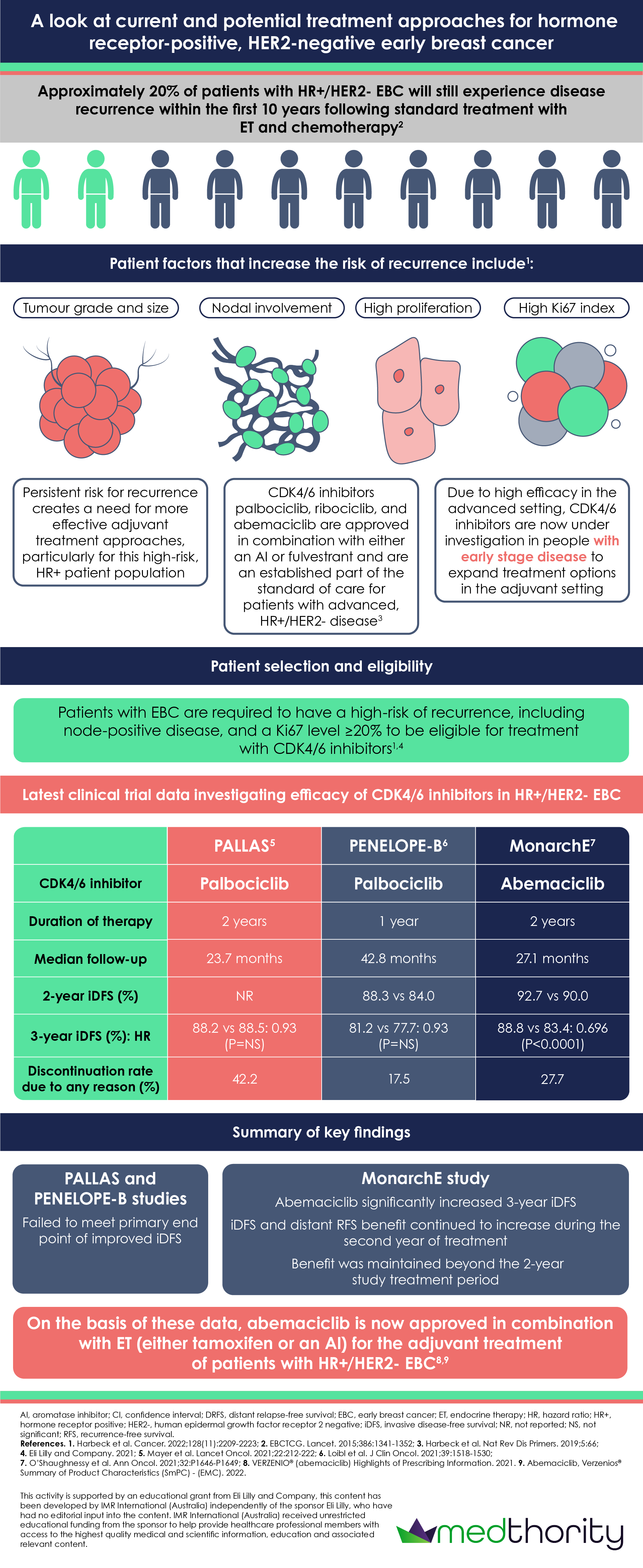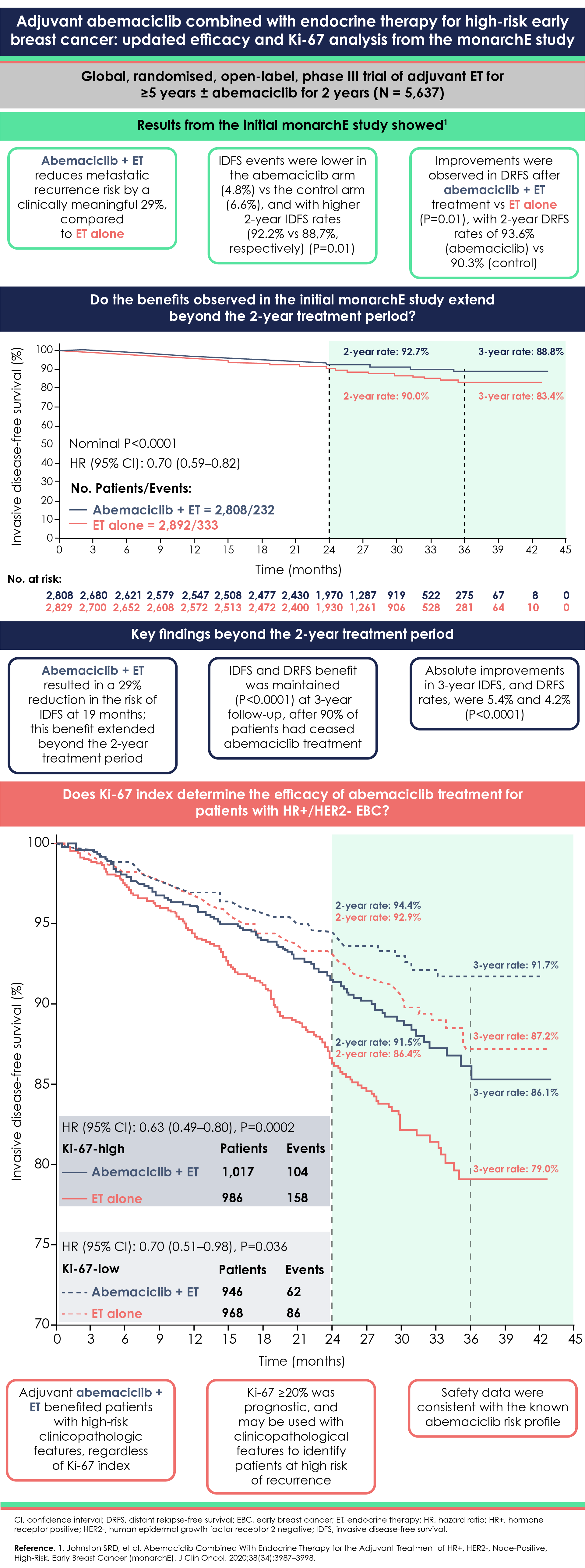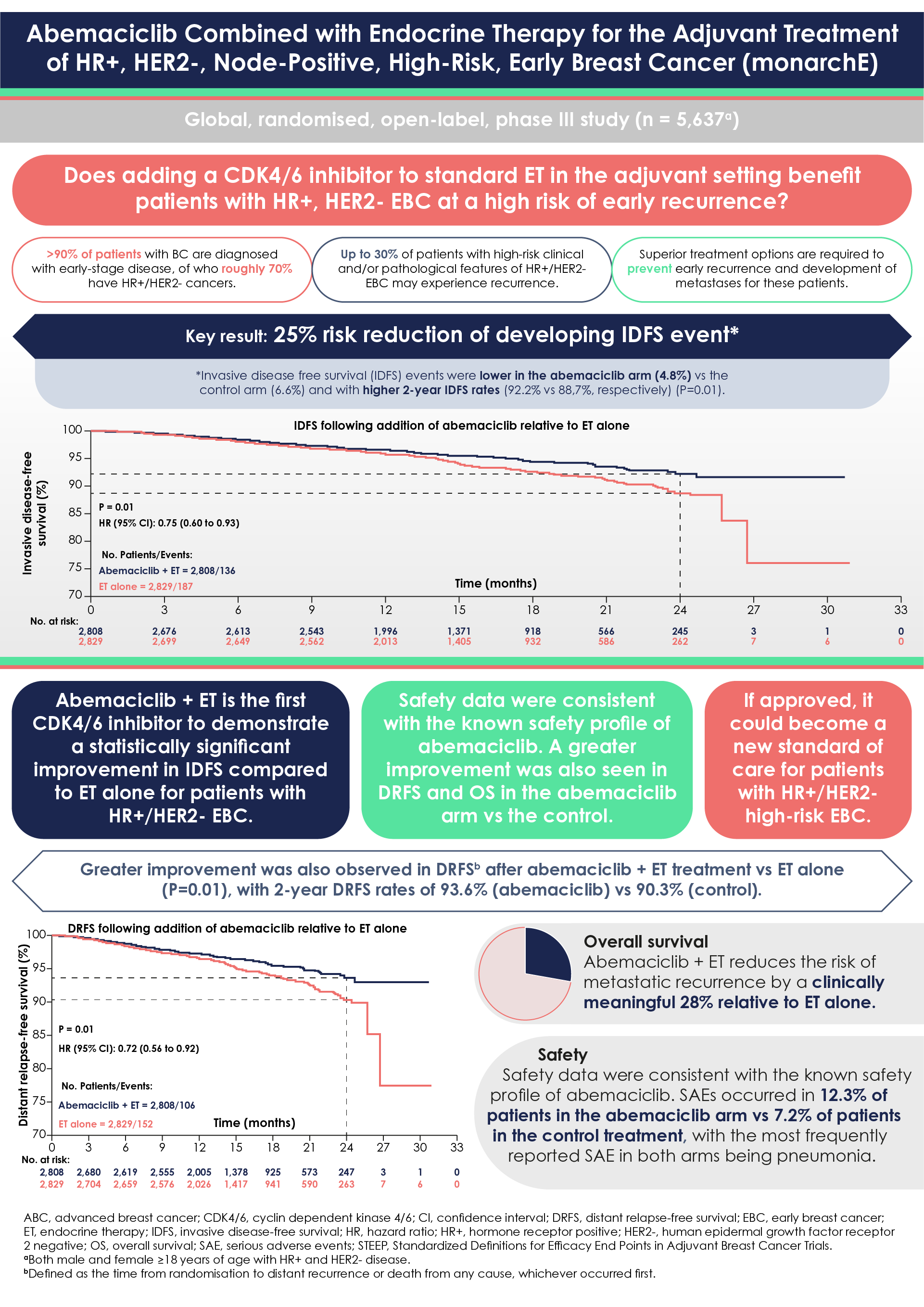
Publication digest
View our publication digests to learn key findings on the use of CDK4/6 inhibitors for treatment of HR+/HER2−, node-positive, high-risk early breast cancer.
- Review data comparing clinical outcomes for various CDK4/6 inhibitors
- Learn the long-term benefits of adjuvant abemaciclib combined with endocrine therapy
- Consider the safety and tolerability profile of this combination therapy for breast cancer
A look at current and potential treatment approaches for hormone receptor-positive, HER2-negative early breast cancer
Harbeck et al. A look at current and potential treatment approaches for hormone receptor-positive, HER2-negative early breast cancer. Cancer. 2022;128: 2209-2223.
Despite the efficacy of current treatment approaches for hormone receptor-positive (HR+), human epidermal growth factor receptor 2 negative (HER2−) early breast cancer (EBC), approximately 20% of patients will still experience disease recurrence within the first 10 years1. Factors that increase this risk include large tumour size, tumour grade, nodal involvement, rate of proliferation (high Ki67 index) and vascular invasion2. Persistent risk for recurrence has driven investigation into the addition of cyclin-dependent kinase 4 and 6 (CDK4/6) inhibitors to adjuvant endocrine therapy (ET)3. CDK4/6 inhibitors abemaciclib, palbociclib and ribociclib have shown efficacy in treatment of advanced HR+/HER2-breast cancer, however clinical studies investigating the efficacy in early breast cancer have demonstrated varying results, with only abemaciclib receiving approval for treatment4-7.

Adjuvant abemaciclib combined with endocrine therapy for high-risk early breast cancer: updated efficacy and Ki-67 analysis from the monarchE study
Harbeck et al. Adjuvant abemaciclib combined with endocrine therapy for high-risk early breast cancer: updated efficacy and Ki-67 analysis from the monarchE study. Ann Oncol. 2021;32(12):1571‒1581.
Adjuvant abemaciclib combined with endocrine therapy (ET) previously demonstrated clinically meaningful improvement in invasive disease-free survival (IDFS) and distant relapse-free survival (DRFS) in hormone receptor-positive (HR+), human epidermal growth factor receptor 2-negative (HER-), node-positive, high-risk early breast cancer (EBC)8. However, follow-up from this study was limited to 24 months, necessitating further investigation. An additional 3-year follow up analysis was therefore performed, which found that adjuvant abemaciclib combined with ET improved IDFS and DRFS, and that the benefit observed in the initial monarchE study extended beyond the 2-year treatment period with a similar safety and tolerability profile9.

CDK4/6 inhibitors in combination with endocrine therapy as potential therapies for treating high-risk early breast cancer patients
Does addition of abemaciclib to endocrine therapy (ET) as an adjuvant treatment of HR+, HER2−, node-positive, high-risk, early breast cancer patients provide additional benefits versus treatment with ET alone?
Johnston S, Harbeck N, Hegg R, Toi M, Martin M, Shao ZM, et al. Abemaciclib combined with endocrine therapy for the adjuvant treatment of HR+, HER2-, node-positive, high-risk, early breast cancer (monarchE). J Clin Oncol. 2020:JCO2002514.
- Up to 30% of patients with high-risk clinical and/or pathological features of HR+/HER2- early breast cancer (EBC) may experience recurrence8
- Superior treatment options are required to prevent early recurrence and development of metastases for these patients8
- Abemaciclib in combination with endocrine therapy is the first CDK4/6 inhibitor to demonstrate significant improvement in invasive disease-free survival (IDFS) patients8
Almost all patients (90%) with breast cancer are diagnosed at an early stage, of whom approximately 70% have HR+, HER2- cancers10,11. Adjuvant endocrine therapy (ET) which is the standard treatment for HR+/HER2- early breast cancer (EBC) has been linked to reducing the risk of recurrence and death12. However, recurrence for patients with high-risk features is high and it is therefore very important to optimise therapy to prevent early recurrences and metastases for these patients8,13.
CDK4/6 inhibitors are currently being used in combination with hormone therapy to treat HR+/HER2- advanced breast cancers14
CDK4/6 inhibitors are currently being used in combination with hormone therapy to treat HR+/HER2- advanced breast cancers14 but whether there is an additional benefit for such treatment in patients with HR+/HER2- EBC is yet to be confirmed. The open-label, phase III monarchE trial discussed here included patients with HR+/HER2-, high-risk EBC to evaluate the combination of the CDK 4/6 inhibitor abemaciclib and standard ET in the adjuvant setting. It concluded that there was a significant improvement in invasive-disease free survival (IDFS) after adding abemaciclib and, if approved, abemaciclib could become the new standard of care for this patient population8.

Johnston et al report on 5,637 patients (both male and female ≥ 18 years of age with HR+ and HER2- disease) from 603 sites in 38 countries who received either abemaciclib (150 mg twice daily) + ET (n=2,808) or ET alone (n=2,829) as a control arm. The primary endpoint was IDFS per the STEEP criteria and measured from the date of randomisation to the date of the first occurrence of recurrence, death due to any cause, contralateral invasive breast cancer or secondary primary non-breast invasive cancer8. The secondary endpoint was the distance relapse-free survival (DRFS), the time from randomisation to distant recurrence or death from any cause, and other secondary endpoints included overall survival, safety, pharmacokinetics, and patient-reported outcomes. Efficacy analyses were carried out on an ITT population with a primary objective to test the superiority of abemaciclib + ET vs ET on IDFS, and the safety analysed in all patients who received at least one dose of study treatment8.
The monarchE study findings indicate that the addition of abemaciclib to standard adjuvant ET resulted in a statistically significant improvement in efficacy. IDFS events were lower in the abemaciclib arm (4.8%) vs the control arm (6.6%) and with higher 2-year IDFS rates (92.2% vs 88,7%, respectively) (P=0.01). Greater improvement was also observed in DRFS after abemaciclib + ET treatment vs ET alone (P=0.01), with 2-year DRFS rates of 93.6% (abemaciclib) vs 90.3% (control)8. Safety data were consistent with the known safety profile of abemaciclib, with the most common adverse events being diarrhoea, neutropenia, and fatigue in the abemaciclib arm and arthralgia, hot flush and fatigue in the control arm. Serious adverse events (SAEs) also occurred in 12.3% of patients in the abemaciclib arm vs 7.2% of patients in the control treatment, with the most common SAE reported in both arms being pneumonia8.
If approved, abemaciclib added to standard adjuvant ET could become a new standard of care for patients with HR+, HER2- high-risk EBC8
Of note, the monarchE study is the first study to report that adding a CDK4/6 inhibitor to ET in the adjuvant setting provides an additional benefit for patients with HR+, HER2- EBC. The results evidently revealed a significant improvement in IDFS following abemaciclib treatment in patients with high-risk EBC in the adjuvant setting. There was a 25% risk reduction in developing IDFS events compared to ET alone and a 3.5% absolute improvement in IDFS rates, with safety consistent with the known safety profile of abemaciclib8. As a result of this study, if abemaciclib added to standard adjuvant ET is approved, it could become a new standard of care for patients with HR+, HER2- high-risk EBC8.
References
- Early Breast Cancer Trialists' Collaborative G. Aromatase inhibitors versus tamoxifen in early breast cancer: patient-level meta-analysis of the randomised trials. Lancet. 2015;386(10001):1341-1352.
- Harbeck N, Penault-Llorca F, Cortes J, Gnant M, Houssami N, Poortmans P, et al. Breast cancer. Nat Rev Dis Primers. 2019;5(1):66.
- Harbeck N, Burstein HJ, Hurvitz SA, Johnston S, Vidal GA. A look at current and potential treatment approaches for hormone receptor-positive, HER2-negative early breast cancer. Cancer. 2022;128 Suppl 11:2209-2223.
- Loibl S, Marme F, Martin M, Untch M, Bonnefoi H, Kim SB, et al. Palbociclib for Residual High-Risk Invasive HR-Positive and HER2-Negative Early Breast Cancer-The Penelope-B Trial. J Clin Oncol. 2021;39(14):1518-1530.
- Mayer EL, Dueck AC, Martin M, Rubovszky G, Burstein HJ, Bellet-Ezquerra M, et al. Palbociclib with adjuvant endocrine therapy in early breast cancer (PALLAS): interim analysis of a multicentre, open-label, randomised, phase 3 study. Lancet Oncol. 2021;22(2):212-222.
- O'Shaughnessy J, Rastogi P, Harbeck N, Toi M, Hegg R, Sohn J, et al. VP8-2021: Adjuvant abemaciclib combined with endocrine therapy (ET): Updated results from monarchE. Annals of Oncology. 2021;32(12):1646-1649.
- O'Shaughnessy JA, Johnston S, Harbeck N, Toi M, Im Y-H, Reinisch M, et al. Abstract GS1-01: Primary outcome analysis of invasive disease-free survival for monarchE: abemaciclib combined with adjuvant endocrine therapy for high risk early breast cancer. Cancer Research. 2021;81(4_Supplement):GS1-01-GS01-01.
- Johnston SRD, Harbeck N, Hegg R, Toi M, Martin M, Shao ZM, et al. Abemaciclib Combined With Endocrine Therapy for the Adjuvant Treatment of HR+, HER2-, Node-Positive, High-Risk, Early Breast Cancer (monarchE). J Clin Oncol. 2020;38(34):3987-3998.
- Harbeck N, Rastogi P, Martin M, Tolaney SM, Shao ZM, Fasching PA, et al. Adjuvant abemaciclib combined with endocrine therapy for high-risk early breast cancer: updated efficacy and Ki-67 analysis from the monarchE study. Ann Oncol. 2021;32(12):1571-1581.
- Cardoso F, Spence D, Mertz S, Corneliussen-James D, Sabelko K, Gralow J, et al. Global analysis of advanced/metastatic breast cancer: Decade report (2005-2015). Breast. 2018;39:131-138.
- Howlader N, Altekruse SF, Li CI, Chen VW, Clarke CA, Ries LA, et al. US incidence of breast cancer subtypes defined by joint hormone receptor and HER2 status. J Natl Cancer Inst. 2014;106(5).
- Lerebours F, Pulido M, Fourme E, Debled M, Becette V, Bonnefoi H, et al. Predictive factors of 5-year relapse-free survival in HR+/HER2- breast cancer patients treated with neoadjuvant endocrine therapy: pooled analysis of two phase 2 trials. Br J Cancer. 2020;122(6):759-765.
- Mamounas EP, Tang G, Paik S, Baehner FL, Liu Q, Jeong JH, et al. 21-Gene Recurrence Score for prognosis and prediction of taxane benefit after adjuvant chemotherapy plus endocrine therapy: results from NSABP B-28/NRG Oncology. Breast Cancer Res Treat. 2018;168(1):69-77.
- Shah M, Nunes MR, Stearns V. CDK4/6 Inhibitors: Game Changers in the Management of Hormone Receptor-Positive Advanced Breast Cancer? Oncology (Williston Park). 2018;32(5):216-222.
of interest
are looking at
saved
next event
This activity is supported by an educational grant from Eli Lilly and Company.
